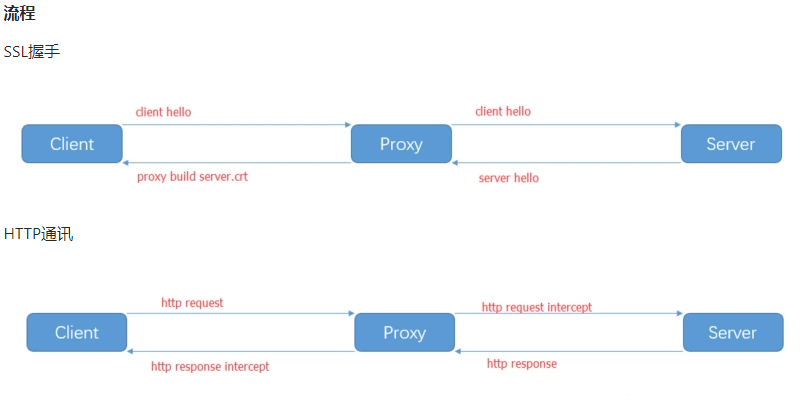使用netty实现代理服务功能,思路是:客户端发送请求,由netty服务端通过端口监听到请求,然后在内部再开启一个netty客户端作为代理去访问真实的服务器,最后由真实的服务器将响应返回给代理,代理再返回给netty服务端,最后返回给浏览器。

目前实现了http和https的代理。
导入依赖:
<dependencies>
<dependency>
<groupId>io.netty</groupId>
<artifactId>netty-buffer</artifactId>
<version>${netty.version}</version>
</dependency>
<dependency>
<groupId>io.netty</groupId>
<artifactId>netty-codec</artifactId>
<version>${netty.version}</version>
</dependency>
<dependency>
<groupId>io.netty</groupId>
<artifactId>netty-codec-http</artifactId>
<version>${netty.version}</version>
</dependency>
<dependency>
<groupId>io.netty</groupId>
<artifactId>netty-handler</artifactId>
<version>${netty.version}</version>
</dependency>
<dependency>
<groupId>io.netty</groupId>
<artifactId>netty-handler-proxy</artifactId>
<version>${netty.version}</version>
</dependency>
<dependency>
<groupId>org.bouncycastle</groupId>
<artifactId>bcpkix-jdk15on</artifactId>
<version>1.58</version>
</dependency>
<dependency>
<groupId>org.springframework.boot</groupId>
<artifactId>spring-boot-starter</artifactId>
</dependency>
<dependency>
<groupId>org.springframework.boot</groupId>
<artifactId>spring-boot-starter-test</artifactId>
<scope>test</scope>
</dependency>
</dependencies>
配置:
websync.port=9999
容器加载后启动程序:
@Component public class Runner implements ApplicationRunner { @Value("${websync.port}") private int port; @Override public void run(ApplicationArguments args) throws Exception { new Server(port).start(); } }
服务端:
public class Server { public final static HttpResponseStatus SUCCESS = new HttpResponseStatus(200, "Connection established"); private final int PORT; private final EventLoopGroup workerStateEvent = new NioEventLoopGroup(); private final EventLoopGroup bossStateEvent = new NioEventLoopGroup(); private final ServerBootstrap bootstrap = new ServerBootstrap(); private final ServerHandler serverHandler = new ServerHandler(); public Server(int PORT) { this.PORT = PORT; } public void start() throws InterruptedException { bootstrap.group(bossStateEvent, workerStateEvent) .channel(NioServerSocketChannel.class) .localAddress(new InetSocketAddress(PORT)) .childHandler(new ChannelInitializer<NioSocketChannel>() { @Override protected void initChannel(NioSocketChannel socketChannel) throws Exception { socketChannel.pipeline().addLast("httpCodec", new HttpServerCodec()); socketChannel.pipeline().addLast("httpObject", new HttpObjectAggregator(65536)); socketChannel.pipeline().addLast(serverHandler); } }); ChannelFuture channel = bootstrap.bind().sync(); //关闭通道 channel.channel().closeFuture().sync(); } }
服务端handler:
//线程间共享,但必须要保证此类线程安全 @ChannelHandler.Sharable public class ServerHandler extends ChannelInboundHandlerAdapter { private final static Log LOG = LogFactory.getLog(ServerHandler.class); //保证线程安全 private ThreadLocal<ChannelFuture> futureThreadLocal = new ThreadLocal<>(); private final AtomicInteger PORT = new AtomicInteger(0); private final AtomicReference<String> HOST = new AtomicReference<String>("0.0.0.0"); @Override public void channelActive(ChannelHandlerContext ctx) throws Exception { LOG.info("服务器连接成功......"); } @Override public void channelRead(final ChannelHandlerContext ctx, final Object msg) { //http if (msg instanceof FullHttpRequest) { FullHttpRequest request = (FullHttpRequest) msg; String name = request.method().name(); RequestProto protoUtil = ProtoUtil.getRequestProto(request); String host = protoUtil.getHost(); int port = protoUtil.getPort(); PORT.set(port); HOST.set(host); request.headers().set("11", "222"); if ("CONNECT".equalsIgnoreCase(name)) {//HTTPS建立代理握手 HttpResponse response = new DefaultFullHttpResponse(HttpVersion.HTTP_1_1, Server.SUCCESS); ctx.writeAndFlush(response); ctx.pipeline().remove("httpCodec"); ctx.pipeline().remove("httpObject"); return; } //开启代理服务器 new ProxyServer(host, port, msg, ctx.channel()).start(); } else { //https,只转发数据,不对数据做处理,所以不需要解密密文 ChannelFuture future = futureThreadLocal.get(); //代理连接还未建立 if (future == null) { //连接至目标服务器 Bootstrap bootstrap = new Bootstrap(); bootstrap.group(ctx.channel().eventLoop()) // 复用客户端连接线程池 .channel(ctx.channel().getClass()) // 使用NioSocketChannel来作为连接用的channel类 .handler(new ChannelInitializer() { @Override protected void initChannel(Channel ch) throws Exception { ch.pipeline().addLast(new ChannelInboundHandlerAdapter() { @Override public void channelRead(ChannelHandlerContext ctx0, Object msg) throws Exception { ctx.channel().writeAndFlush(msg); } @Override public void channelActive(ChannelHandlerContext ctx) throws Exception { System.out.println("https 代理服务器连接成功..."); } }); } }); future = bootstrap.connect(HOST.get(), PORT.get()); futureThreadLocal.set(future); future.addListener(new ChannelFutureListener() { public void operationComplete(ChannelFuture future) throws Exception { if (future.isSuccess()) { future.channel().writeAndFlush(msg); } else { ctx.channel().close(); } } }); } else { //代理建立连接之后,直接刷回数据 future.channel().writeAndFlush(msg); } } } }
代理客户端:
public class ProxyServer { private final String HOST; private final int PORT; private final Object msg; private final Channel channel; public ProxyServer(String HOST, int PORT, Object msg, Channel channel) { this.HOST = HOST; this.PORT = PORT; this.msg = msg; this.channel = channel; } public void start() { Bootstrap bootstrap = new Bootstrap(); EventLoopGroup group = new NioEventLoopGroup(); bootstrap.group(group) .channel(NioSocketChannel.class) .handler(new ChannelInitializer<Channel>() { @Override protected void initChannel(Channel socketChannel) throws Exception { socketChannel.pipeline().addLast(new HttpClientCodec()); socketChannel.pipeline().addLast(new HttpObjectAggregator(6553600)); socketChannel.pipeline().addLast(new ProxyServerHandler(channel)); } }) .connect(new InetSocketAddress(HOST, PORT)) .addListener(new ChannelFutureListener() { public void operationComplete(ChannelFuture future) throws Exception { if (future.isSuccess()) { HeaderUtil.addHeaders(future, msg); } else { future.channel().close(); } } }); } }
代理handler:
public class ProxyServerHandler extends ChannelInboundHandlerAdapter { private Channel channel; public ProxyServerHandler(Channel channel) { this.channel = channel; } @Override public void channelActive(ChannelHandlerContext ctx) throws Exception { System.out.println("代理服务器连接成功....."); } @Override public void channelRead(ChannelHandlerContext ctx, Object msg) throws Exception { channel.writeAndFlush(msg); } }
工具类:
public class HeaderUtil { /** * @methodName: addHeaders * @description: 添加headers信息,响应客户端 * @auther: CemB * @date: 2018/12/20 17:18 */ public static void addHeaders(ChannelFuture future, Object request) { if (request instanceof HttpRequest) { HttpRequest msg = (FullHttpRequest) request; msg.headers().set("111", "222"); future.channel().writeAndFlush(msg); } else { future.channel().writeAndFlush(request); } } }
public class ProtoUtil { public static RequestProto getRequestProto(HttpRequest httpRequest) { RequestProto requestProto = new RequestProto(); int port = -1; String hostStr = httpRequest.headers().get(HttpHeaderNames.HOST); if (hostStr == null) { Pattern pattern = Pattern.compile("^(?:https?://)?(?<host>[^/]*)/?.*$"); Matcher matcher = pattern.matcher(httpRequest.uri()); if (matcher.find()) { hostStr = matcher.group("host"); } else { return null; } } String uriStr = httpRequest.uri(); Pattern pattern = Pattern.compile("^(?:https?://)?(?<host>[^:]*)(?::(?<port>\d+))?(/.*)?$"); Matcher matcher = pattern.matcher(hostStr); //先从host上取端口号没取到再从uri上取端口号 issues#4 String portTemp = null; if (matcher.find()) { requestProto.setHost(matcher.group("host")); portTemp = matcher.group("port"); if (portTemp == null) { matcher = pattern.matcher(uriStr); if (matcher.find()) { portTemp = matcher.group("port"); } } } if (portTemp != null) { port = Integer.parseInt(portTemp); } boolean isSsl = uriStr.indexOf("https") == 0 || hostStr.indexOf("https") == 0; if (port == -1) { if (isSsl) { port = 443; } else { port = 80; } } requestProto.setPort(port); requestProto.setSsl(isSsl); return requestProto; } public static class RequestProto implements Serializable { private static final long serialVersionUID = -6471051659605127698L; private String host; private int port; private boolean ssl; public RequestProto() { } public RequestProto(String host, int port, boolean ssl) { this.host = host; this.port = port; this.ssl = ssl; } public String getHost() { return host; } public void setHost(String host) { this.host = host; } public int getPort() { return port; } public void setPort(int port) { this.port = port; } public boolean getSsl() { return ssl; } public void setSsl(boolean ssl) { this.ssl = ssl; } } }